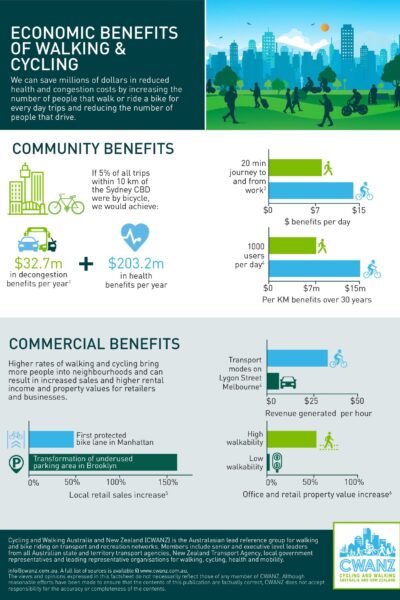Resources
This page contains some key resources on walking and cycling, including an archive of the documents produced by the Australian Bicycle Council.
| Date Added | |||
|---|---|---|---|
 |
Active Travel to Schools Programs CWANZ An overview of active travel to schools programs across Australia and New Zealand, their key features and what makes them successful. Also includes a comparison of the number of children that use active travel to school from around the world. |
23/08/2023 | View |
 |
Personal mobility devices Department of Transport and Main Roads, Queensland Know your way around Personal Mobility Devices such as e-scooters, e-skateboards and segways.
|
01/05/2023 | View |
 |
CWANZ Fact Sheet: Safety CWANZ Research has repeatedly shown that the more people walking or riding a bike, the safer it is for everyone. Reducing the number of cars and speed limits in built-up areas reduces the risk of death or injury to our most vulnerable road users. Growth in cycling is best achieved through separated cycle lanes and reduced speed limits. |
28/04/2022 | View |
 |
CWANZ Fact Sheet: Economic Benefits of Walking & Cycling CWANZ We can save millions of dollars in reduced health and congestion costs by increasing the number of people that walk or ride a bike for every day trips and reducing the number of people that drive. |
19/04/2022 | View |
 |
CWANZ Fact Sheet: Benefits of Lower Speed Limits CWANZ Benefits of lower speed limits in high activity areas and local access streets. What happens when vehicles travel more slowly in areas with lots of pedestrians and bike riders? |
19/04/2022 | View |
 |
CWANZ Fact Sheet: Health Benefits of Active Transport CWANZ Physical inactivity is one of the top 10 risk factors contributing to disease in Australia, contributing to 2.5% of the total burden of disease and is the 5th highest behavioural risk factor, behind tobacco use, diet, alcohol and illicit drug use. |
19/04/2022 | View |
 |
CWANZ Fact Sheet: Costs of Transport and Physical Inactivity CWANZ Congestion costs, transport costs and healthcare costs of physical inactivity. |
13/04/2022 | View |
 |
CWANZ Fact Sheet: More People Bike Riding - Keys to Success CWANZ When bike riding is easy, safe and more convenient than other transport options, more people will ride. Increasing physical activity improves health, saves costs and takes the |
13/04/2022 | View |
 |
CWANZ Factsheet: More People Walking - Keys to Success CWANZ Walking is for everyone, regardless of age and ability. Walkers include people on foot, people with crutches, people with canes, people in wheelchairs, and people in mobility scooters. Evidence consistently shows that by providing pedestrian-friendly neighbourhoods, quality public spaces, a mix of land uses, and housing densities, more people will walk, giving health, environmental, transport and community benefits. |
13/04/2022 | View |
